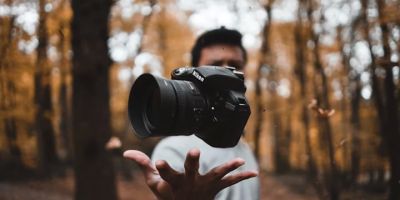What is the Golden Hour?
The golden hour, often referred to as the magic hour by photographers, is that brief period after sunrise and before sunset when the sunlight is soft, warm, and diffused. It's a photographer's dream, offering the perfect conditions to create stunning photos. The soft, warm glow of the light can enhance your subjects, creating a flattering and atmospheric effect that is hard to replicate at other times of the day. This period can last anywhere from 20 minutes to over an hour, depending on your location and the time of year. But, how exactly can we make the most of this beautiful light? Let's dive into some of the key tips and techniques for shooting during the golden hour.
Why is the Golden Hour Special for Photography?
The golden hour offers several advantages over shooting during midday when the sun is high. At midday, the harsh, direct light can create unflattering shadows and high contrast. The golden hour light, on the other hand, has a much softer quality that reduces harsh shadows and creates a pleasing warm tone. The low angle of the sun during this time also allows for long, dramatic shadows that can add depth and interest to your photos. It’s the perfect light for both portraits and landscape photography.
1. Plan Ahead for the Best Results
One of the most important things to keep in mind when shooting during the golden hour is timing. The light changes quickly, so it's crucial to plan ahead. Use apps like Golden Hour or Photographer's Ephemeris to track the exact time the golden hour starts and ends in your location. Keep in mind that the golden hour will vary depending on the season and your geographical location. If you’re shooting on a beach, a mountain, or in an urban area, the light will also be affected by the landscape and the buildings around you.
2. Understand the Direction of Light
The direction from which the light is coming plays a significant role in how your photos turn out. At golden hour, the light comes from a low angle, so positioning yourself in relation to the sun can create different moods in your images. If you shoot with the sun behind your subject, you’ll get a beautiful backlight effect, which can create a dreamy, halo-like glow around your subject. On the other hand, shooting with the sun facing your subject will provide softer, even lighting that flatters most subjects, especially portraits.
3. Use the Right Camera Settings
To get the best out of the golden hour light, it’s important to adjust your camera settings. The low light conditions during this time mean you’ll need to tweak a few settings to avoid underexposure. Increase your ISO slightly, but don’t go too high as this can introduce noise into your images. Set your aperture to a wide setting (low f-number) to allow as much light in as possible, especially if you're shooting portraits. Lastly, keep your shutter speed high enough to avoid motion blur, especially if you’re shooting moving subjects. Experiment with different settings until you find what works best for your style.
4. Adjust Your White Balance for Warmth
Another important aspect to consider is the white balance. Golden hour light has a warm, yellow-orange tint, which is one of the reasons why photos taken during this time look so beautiful. However, if your white balance is set incorrectly, your photos may appear too yellow or too blue. To enhance the golden hour effect, set your camera's white balance to ‘cloudy’ or ‘shade’ mode. These settings will emphasize the warm tones of the light, adding to the overall warmth of your image.
5. Experiment with Silhouettes
The golden hour is the perfect time to experiment with silhouettes. Since the sun is low on the horizon, you can place your subject in front of the light, creating a dark outline of your subject against the bright background. This technique works well for portraits, landscapes, and architectural shots. Just make sure your subject is relatively close to the light source and that they don’t have too much ambient light around them. If you're not familiar with silhouette photography, try starting with simple objects or people in the frame to see how the light interacts with the shapes.
6. Capture the Sky and Landscape
While portraits are a popular choice during the golden hour, don’t forget to take advantage of the stunning skies and landscapes around you. The golden hour is the best time to capture vibrant skies with soft, rich hues of orange, pink, and purple. Whether you're in a city, the countryside, or near the ocean, use the golden hour to capture the mood of the landscape. The changing colors and the dramatic shadows cast by the sun will give your landscape photos a magical, otherworldly quality.
7. Be Ready to Adjust Quickly
The golden hour light is fleeting, and the colors in the sky will change quickly. As the sun gets closer to the horizon, the light will become more intense and colorful, but the window to capture the perfect shot is short. Stay on your toes and be ready to make adjustments to your settings and framing as the light changes. If you're shooting with a tripod, take advantage of long exposure times to capture more details in the shadows as the light dims. And remember, you don’t need to rush. Take your time to compose your shot thoughtfully and be ready to react to the shifting light.
8. Don’t Forget the Magic After the Sunset
Many people assume that the golden hour ends when the sun sets, but that’s not entirely true. The "blue hour" follows the golden hour, which offers another opportunity to capture unique and beautiful photos. The light during the blue hour is cool and soft, with deep blues and purples in the sky. If you’re still outside after the sun goes down, you can capture a completely different vibe, perfect for cityscapes or long-exposure shots of stars.
Real-Life Example: A Sunset Photo Shoot
One of my most memorable golden hour experiences happened during a trip to the Grand Canyon. I had the perfect view of the sun setting over the canyon's edge, and the colors in the sky were changing by the minute. I set my camera to a wide aperture and made sure I had my ISO set to a comfortable level to avoid too much noise in the image. As the sun dipped lower, I moved closer to the edge to take advantage of the light hitting the rocks, and the resulting shot was one of the most stunning landscape photos I've ever taken.





